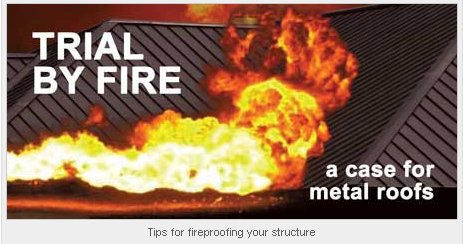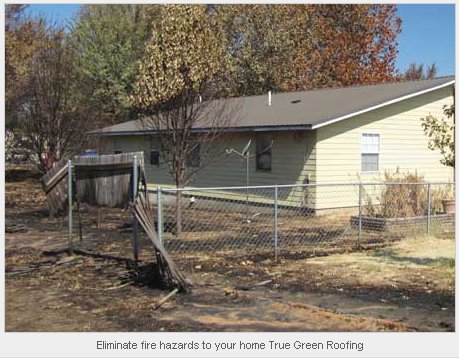Trial by fire: Tips for fireproofing your structure – March 2013
Last year was a record year for forest fires in the United States. In Oklahoma, up to 18 simultaneous fires were being fought in August, with especially damaging results in Luther, Drumright and Mannford. In Colorado, hundreds of homes were destroyed by forest fire. Fires in Oregon were record setting, as well as New Mexico, Idaho, Nebraska and California. The extreme summer heat and widespread drought turned the West into a tinderbox. Millions of acres burned, and thousands of homes were lost. More than ever as contractors and builders, our attentions are turned to the importance of fire protection.
Forest fires are more than just fire. They can become a “firestorm”—a deadly mix of unending fuel supply and thermally-induced high winds that roll into a blast furnace, and approach, uninvited, with the speed and power of a locomotive. Seemingly non-combustible materials burn or disintegrate. Sheer winds uproot trees, fences and roofs with unnatural ease. Superheated embers fly, bounce and crawl into fresh territories to advance the wall of flames ever faster. To understand this power, picture a 3,000 square foot house burned to its foundation in less than eight minutes. It has been described by its victims as a “fire-tornado.” Often, fire breaks are the only answer, starving the flames of combustibles that fuel its insatiable appetite.
At the edge of the fire-line, things can be stranger still, with sharp demarcations between the burned and unscathed. You may find half a tree charred to ash, while still leafy and green on the far side, or an entire area burned to the ground, except one small structure, seemingly untouched by flame.
Forest fires can lay waste to everything, leaving behind nothing but ashes, wreckage and memories. What can be done to brace against such disasters? As we’ve witnessed in recent events such as the Waldo Canyon fire in Colorado, quite possibly nothing, short of a fire break. Still, there are many efforts that you can make in your building and landscape design to ensure the property is more fire-resistant, and may stave off more serious destruction.
The forest fire in the Mannford/Drumright vicinity of Oklahoma provides a prime example. Between the trees and the underbrush, this fire spread quickly throughout a large rural area southwest of Tulsa. Areas with large, grassy lawns created natural barriers that stalled the advance of the flames. Woodsy areas were overrun quickly, as burning embers dropped from trees onto rooftops. Yet, one property located in a tree-shaded area survived, even though buildings all around it were burned to their foundations. Why? In a forest fire, it’s the roof that goes first.
This residence has an MPI metal roof professionally installed by Metals Better along with fire-resistant siding. While nothing is guaranteed fire-proof, a metal roof creates an excellent barrier against falling embers. This home had flames directly up against the back wall, which burned the window casings, and flames as close as fifteen feet from the front door, yet it still stands today. There are other such similar stories; two homes still standing after the recent Washington state fire; after a fire in Oakland, Calif., took over 3,000 homes, one remained unharmed. What did they have in common? They had a cleared zone around the dwelling and a fire-resistant metal roof. According to Jack Cohen, USDA Forest Service, “The higher the fire intensifies near the home, the greater the need for nonflammable construction materials and a resistant building design.” Simply stated by the NFPA, “The roof is the most important element of the home. Use fire-rated roofing materials.”
Contractors, would your new construction stand up against a forest fire? The following short list is intended to get you thinking, and help you get started on your own fire prevention program. You might recommend to your customers great resources for residential and community fire safety at www.firewise.org or www.nfpa.org.
Walk the property, and look up Encroaching trees with overlapping crowns, proximity to other buildings and prevailing winds can make the property an easy reach for forest fires. If a building is in a high fire-risk area, create a “green belt” around the structure—usually referred to as Zone 1. This is a 30 feet clearance on all sides of the structure, free of combustibles including dead brush, firewood, propane tanks or debris. Trees near a house may look cozy, but to be safe, clear out all trees from zone 1 of the property. If that is not possible, trim overhanging branches a minimum of 6 feet away from the building. Keep lawns and foundation landscaping in the green belt low and well-watered.
Create a “fuel-free” zone around the buildings Keep gutters and downspouts clear of debris, and consider specifying decorative stone, rather than mulch near the building. Consider your landscape design for fire safety; keep portable or permanently installed gas grills away from the house. Combustible outbuildings and garden structures like gazebos, bridges or decorative wells can invite fire closer to the building; make sure these structures are a good distance away from the primary structure. If you have wood fencing attached to the building, this can lead fire straight to your structure like a wick. Create a barrier of non-flammable fencing a minimum of 6 to 10 feet from the property walls.
Some exterior elements can create fuel for a fire. It is important to eliminate these fire hazards.

This photo shows the same property after fire hazards have been cleaned up.
If a building is in a high fire danger area, it is mandatory that you use fire-rated materials on your construction. For roofing, metal, slate, tile and some fire-rated fiberglass or polymer tiles may do the job. A metal roof with a Class A rating is an excellent deterrent against fire. For instance, most steel panels offered by Metal Panels Inc. are UL-rated, Class-A fire-rated and Class IV impact-rated. Always check with your supplier for these ratings and consider the risk in your construction location.
If your roof has skylights, use tempered glass skylights, rather than plastic ones. Consider siding materials that are fire-resistant, such as fiber-cement shingles or clapboards. Close up all cracks, spaces, overhangs and decks that may shelter embers, including walling in all under-deck spaces.
Double paned or tempered glass windows offer extra protection that can help keep a fire from entering the interior of your structure. The temperature differential between the hot forest-fire air outside and cooler attic air can cause a strong vacuum effect, pulling fire into the structure.
Use a finer, 1/8th-inch opening steel screen on your eaves vents; while coarse screening may keep out the birds, you will need something smaller to keep airborne embers from being pulled into attic spaces.
Create fire breaks in your landscape design Use driveways, walkways and water features to create vegetation barriers. Even low stone or cinder block walls along the property line can serve as an effective fire break. Prune trees so that trunks are clear of branches and undergrowth 6 to 10 feet from the ground.
Questions?
If you are looking for a new roof or metal roof, then please call
True Green Roofing Solutions or just take a moment and complete
our Request-a-Quote form.
You Have Options!
Don’t wait to schedule your professional estimate!
Call Us Today! (775) 225-1590
